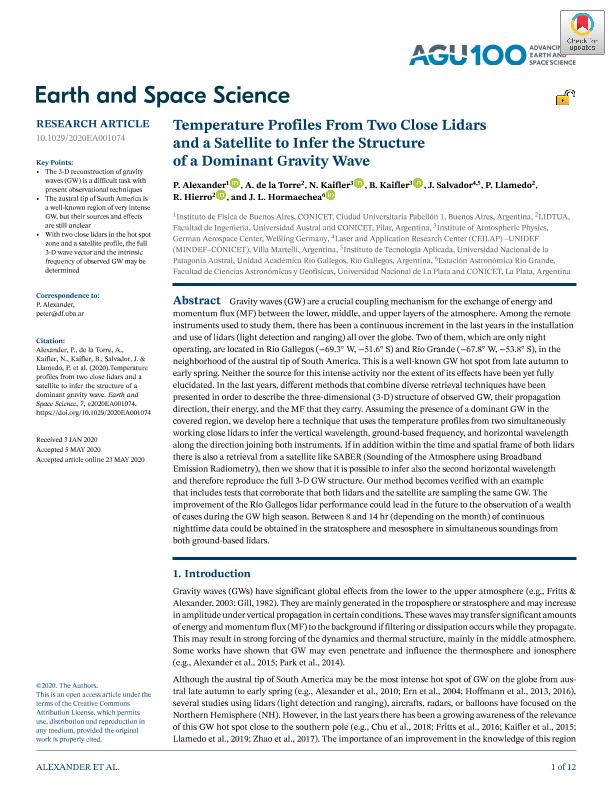Artículo
Temperature Profiles From Two Close Lidars and a Satellite to Infer the Structure of a Dominant Gravity Wave
Alexander, Pedro Manfredo ; de la Torre, Alejandro
; de la Torre, Alejandro ; Kaifler, Natalie; Kaifler, B.; Salvador, Jacobo Omar
; Kaifler, Natalie; Kaifler, B.; Salvador, Jacobo Omar ; Llamedo Soria, Pablo Martin
; Llamedo Soria, Pablo Martin ; Hierro, Rodrigo Federico
; Hierro, Rodrigo Federico ; Hormaechea, José Luis
; Hormaechea, José Luis
 ; de la Torre, Alejandro
; de la Torre, Alejandro ; Kaifler, Natalie; Kaifler, B.; Salvador, Jacobo Omar
; Kaifler, Natalie; Kaifler, B.; Salvador, Jacobo Omar ; Llamedo Soria, Pablo Martin
; Llamedo Soria, Pablo Martin ; Hierro, Rodrigo Federico
; Hierro, Rodrigo Federico ; Hormaechea, José Luis
; Hormaechea, José Luis
Fecha de publicación:
07/2020
Editorial:
John Wiley & Sons Inc.
Revista:
Earth and Space Science
e-ISSN:
2333-5084
Idioma:
Inglés
Tipo de recurso:
Artículo publicado
Clasificación temática:
Resumen
Gravity waves (GW) are a crucial coupling mechanism for the exchange of energy and momentum flux (MF) between the lower, middle, and upper layers of the atmosphere. Among the remote instruments used to study them, there has been a continuous increment in the last years in the installation and use of lidars (light detection and ranging) all over the globe. Two of them, which are only night operating, are located in Río Gallegos (−69.3° W, −51.6° S) and Río Grande (−67.8° W, −53.8° S), in the neighborhood of the austral tip of South America. This is a well-known GW hot spot from late autumn to early spring. Neither the source for this intense activity nor the extent of its effects have been yet fully elucidated. In the last years, different methods that combine diverse retrieval techniques have been presented in order to describe the three-dimensional (3-D) structure of observed GW, their propagation direction, their energy, and the MF that they carry. Assuming the presence of a dominant GW in the covered region, we develop here a technique that uses the temperature profiles from two simultaneously working close lidars to infer the vertical wavelength, ground-based frequency, and horizontal wavelength along the direction joining both instruments. If in addition within the time and spatial frame of both lidars there is also a retrieval from a satellite like SABER (Sounding of the Atmosphere using Broadband Emission Radiometry), then we show that it is possible to infer also the second horizontal wavelength and therefore reproduce the full 3-D GW structure. Our method becomes verified with an example that includes tests that corroborate that both lidars and the satellite are sampling the same GW. The improvement of the Río Gallegos lidar performance could lead in the future to the observation of a wealth of cases during the GW high season. Between 8 and 14 hr (depending on the month) of continuous nighttime data could be obtained in the stratosphere and mesosphere in simultaneous soundings from both ground-based lidars.
Palabras clave:
GRAVITY WAVES
,
LIDAR
,
SOUTHERN PATAGONIA
Archivos asociados
Licencia
Identificadores
Colecciones
Articulos(SEDE CENTRAL)
Articulos de SEDE CENTRAL
Articulos de SEDE CENTRAL
Citación
Alexander, Pedro Manfredo; de la Torre, Alejandro; Kaifler, Natalie; Kaifler, B.; Salvador, Jacobo Omar; et al.; Temperature Profiles From Two Close Lidars and a Satellite to Infer the Structure of a Dominant Gravity Wave; John Wiley & Sons Inc.; Earth and Space Science; 7; 7; 7-2020; 1-12
Compartir
Altmétricas



